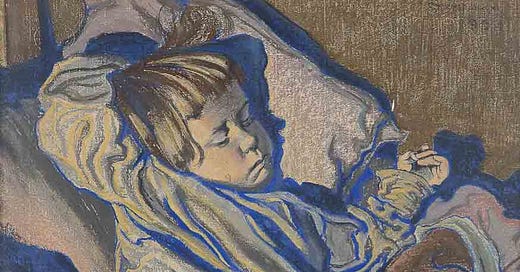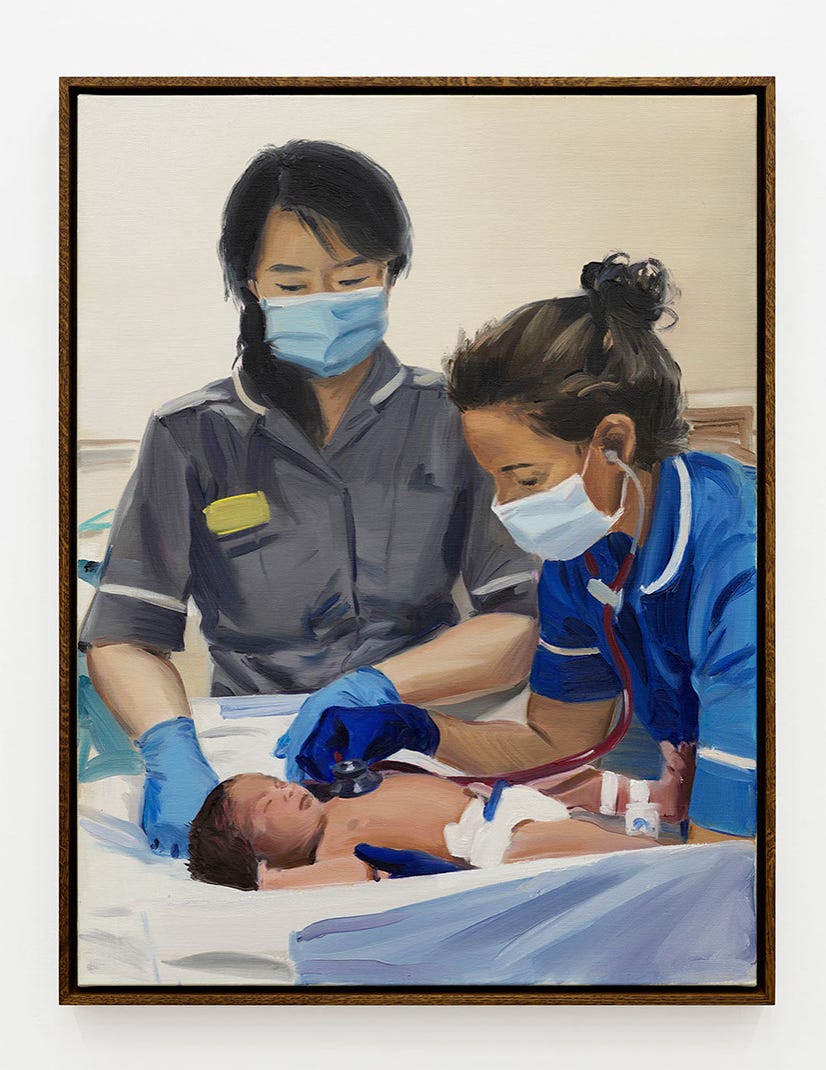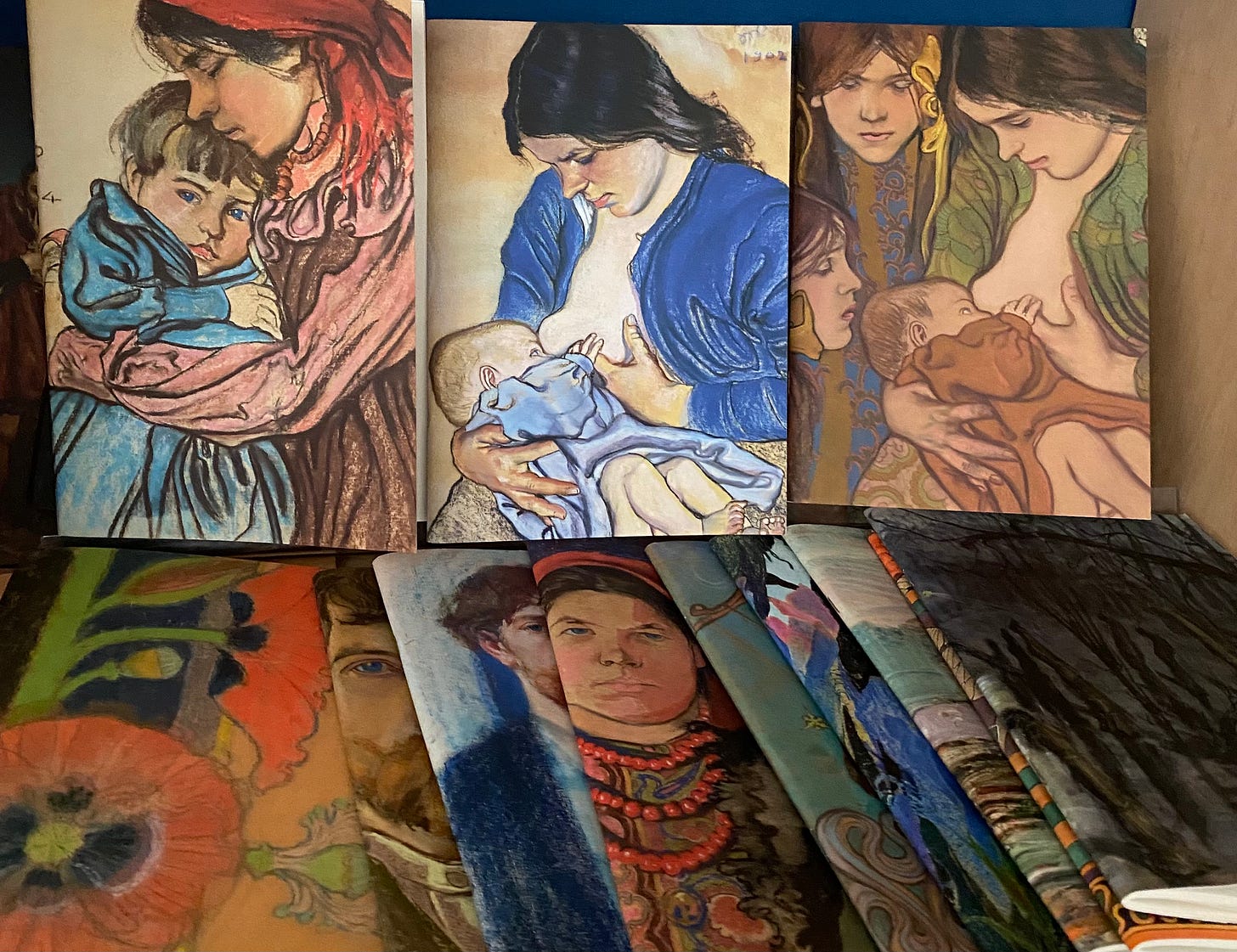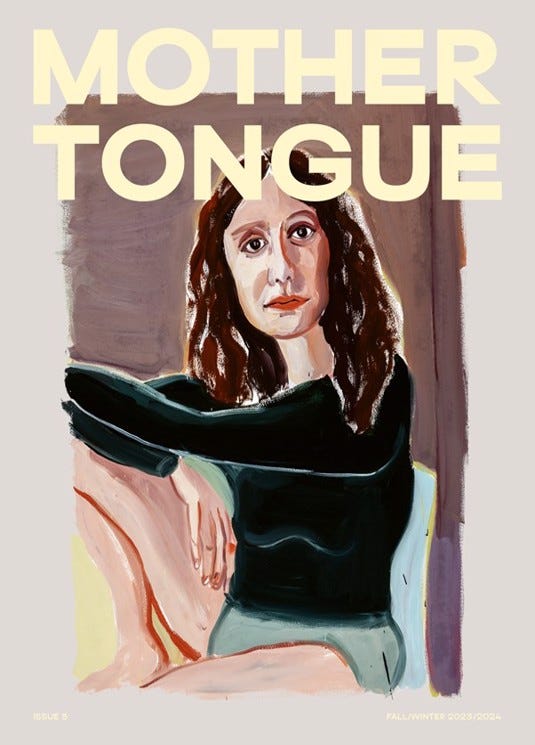Fragments of Art, Fragments of Care
On the parts that unite and divide us, with writer Olga Ravn & painter Caroline Walker in conversation & more.
A few of weeks ago I attended a talk at the Barbican Centre between the painter Caroline Walker and Danish writer and novelist Olga Ravn about creating work around and about motherhood. Ahead of the presentation, Walker picked out passages from Ravn’s recent book, My Work, a poignant and hard-to-shake volume about early motherhood. Ravn did the same, choosing images of Walker’s large-scale paintings, in particular a series Walker did as part of a residency at a hospital maternity and labour ward. The paintings and words were displayed on a large screen, side-by-side while the women discussed inspiration for their own work, why this work by the other artist moved them, and what it means to be a mother today, and especially, a mother-artist. I’ve written about Walker’s work before here and here.
First up was Walker’s painting, Bottles and Pumps, of a kitchen sink filled with sterilized bottles and Medela breast-pump parts. The image sparked a discussion between Walker and Ravn around the objects of motherhood. The artists came back to this idea of mothering through objects throughout the night, even referencing the baby as a new, unfamiliar object that appears in a mother’s life. It made me think of all the small but invaluable things I needed with a small baby and how if one of those objects was misplaced, panic would ensue. (Think: soothers/dummies but also nipple shields with my second, and yes, the tiny parts of the Medela pump that were always lost.) Not long ago, we found a dusty pacifier behind the bed and if felt like we had unearthed a relic from 100 years ago.
Fragments of care.
While cleaning out my children’s closet a while back, I posted something online about how the work of putting away baby clothes, any clothes children have outgrown, is not only domestic labour but emotionally-trying work. You see the baby that once was in those tiny socks, that little sleeper and you neatly fold the clothing away, and in turn, the idea of the baby, almost as if nothing ever happened and it was all a dream. When I saw Walker’s image of bottles and pumps, I felt both a nostalgic pang but also, an incomprehensible detachment I could not explain.
Fragments of time.
“Really I’m interested in the gap between the established truths we tell each other about pregnancy, childbirth, maternity leave and childrearing, and how people actually feel.”
– Olga Ravn, My Work, translated by Sophia Hersi Smith and Jennifer Russell.
Next was Walker’s painting of a birthing pool and again, the discussion turned to the objects in the image: the candle, the water bottle, the art in the room that made the environment less sterile in comparison with a birthing space on the regular labour ward.
Fragments of comfort.
Although it was not shown in this talk, one of my favourite paintings from Walker’s maternity ward series is that of an operating room/theatre after a C-section. I first saw the painting in a show at the majestical Fitzrovia Chapel a few years ago and was so moved by the details: the mother’s head tilted to watch the midwife and the nurse check the baby, the rest of the medical team working on the mother, the IV, the overhead lights. C-sections are so rarely portrayed in art and movies and seeing this painting, especially against the backdrop of a holy place like a chapel, acknowledged the power and beauty of all types of birth.
In another one of Walker’s paintings, Ravn pointed out a new baby’s raised arm and how life-like it seemed, because of the way newborn babies naturally position themselves in that way. There was talk of the way baby legs move back-and-forth and the sound of a diaper being taken off – all of the fragments of new baby existence that disappear so quickly as a child grows.
Fragments of babyhood.
The prevailing subject was that of care work as maintenance (always!) but also about the medical professionals that are witnesses to the births of babies and the moments when mothers believe they may encounter death, the doctors, midwives, nurses never to be seen again after the mothers and babies leave the hospital.
Fragments of observation and memory.
(I especially loved this discussion as I still remember so many of the faces, and some names, of the healthcare professionals who took care of me while pregnant, during childbirth and postpartum. I also remember a few not-so fondly for different reasons but ones that will stay with me forever.)
But fragments are also synonymous with wreckages, with pieces, with shatters and crumbles. I began writing this newsletter from Krakow, Poland where I was for a couple of days to see family and to do some book research. As I walked through the beautiful Jewish quarter, Kazimierz, a bench near where my children played was plastered with “Missing People” posters. My son asked me who all these people were who were “Porwani” (kidnapped). I looked closer and they were the faces of the Israeli hostages, taken by Hamas on October 7th.
Fragments of hope and suffering.
I have not been on social media much recently mostly due to time constraints. When I do start to scroll at random hours in the night, my feed is inundated with clips of wreckages, of rubble, of shattered lives, destroyed homes, human remains and so much loss and suffering. A clip of a little Palestinian girl yelling “Mama” over and over again broke me last week.
Fragments of a common language and a fragmented life forever.
In Krakow, reminders of war and inhumane suffering are everywhere in its history, because it is a city where so many atrocities occurred. But it is not really “history” either, as war, death and genocide is devastatingly as we are witnessing, never in the past. The snippets of Ukrainian I kept hearing on the streets in Krakow were a stark reminder of the homes people have lost and had to recreate in Poland after the Russian invasion, a war that also continues.
Fragments of borders, fragments of language, fragments of buildings, fragments of families, fragments of humanity but also, so so much inhumanity. Fragments of lives lived & lives destroyed. The list goes on.
I do not know how to conclude, except perhaps to return to how this essay started. Ravn’s My Work, is itself a collection of fragments: prose, poetry, diary entries, criticism. Walker’s art is also a fragmented reality, captured on the canvas, of caregiving and carework: night feeds, putting away baby clothes, hanging laundry, cleaning. All of these fragments create a whole. The artists finished their talk with noting how care work—laundry, mothering, cleaning, feeding—should be elevated to the same level as other professional endeavours, like writing a book, or painting, for example. It was a hopeful ending.
Fragment of hope.
Take care of one another.
Wait! Before you go, some more art to soothe your soul a little:
While in Krakow, I visited the Wyspiański Museum, dedicated to the Polish painter, poet and playwright, Stanisław Wyspiański. He is known for his incredible stained-glass window work, but I especially adore his drawings and paintings of his wife and children and his Motherhood series. When I saw this illustration of one of his children sleeping, I immediately thought of the conversation between Ravn and Walker about the way babies and children sleep. Below, a few more of my favourite works by Wyspiański.
Mother Tongue magazine has a new issue! And the cover star is none other than the aforementioned Danish writer Olga Ravn. My friends over at the mag reminded me of the Barbican Centre event (thank you for the DM!). Although I had purchased a ticket, I completely forget about the date and would have missed it. Ravn graces the cover of the magazine, a painting by artist Jenni Hiltunen. The interview by Hillary Kelly is wonderful, especially the parts about what it is and what it means to write about childbirth and motherhood. I am always so honoured to be a contributing editor for the mag as it just keeps getting better and better with every issue. So much good stuff in this one. You can order here.












